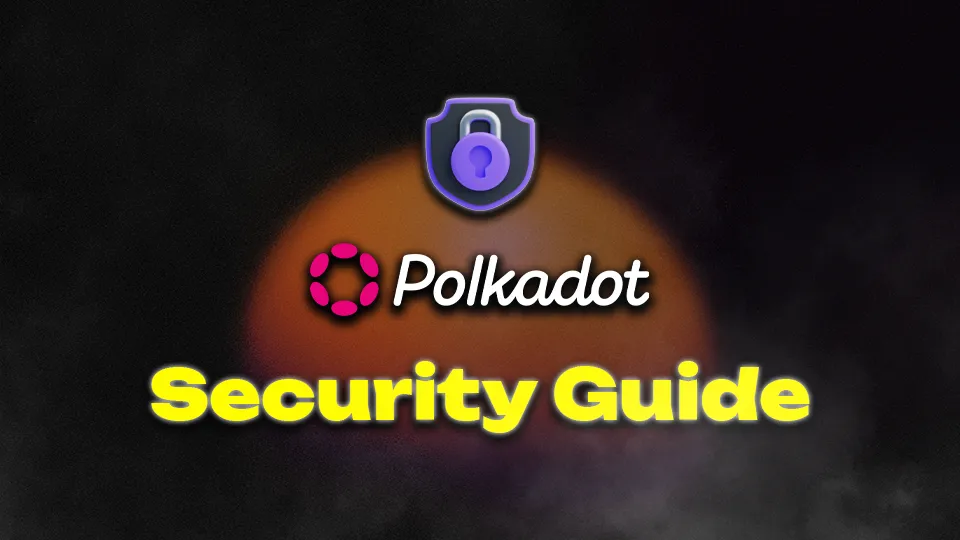Polkadot offers immense potential for developers, investors, and users alike. However, the decentralized nature of blockchain also means that individuals must take proactive steps to protect their assets and personal information from scams and malicious actors.
This comprehensive guide is designed to provide beginners with a thorough understanding of the security measures necessary to safely navigate the Polkadot ecosystem. By following these best practices, users can significantly reduce their risk of falling victim to scams and ensure that their experience in the Polkadot network remains secure and enjoyable.
Understanding the Importance of Key Security
One of the most critical aspects of blockchain security is the management of private keys and seed phrases. These cryptographic keys are the only means of accessing and managing a user’s account and assets on the Polkadot network. Unlike traditional financial systems, where lost passwords can often be recovered through customer service, blockchain accounts are entirely under the user’s control. This means that if a private key or seed phrase is lost or stolen, the associated funds are likely gone forever.
Blockchain & Polkadot Security Essentials:
- Never Share Your Seed Phrase or Private Key: Your seed phrase and private key should be kept private at all times. Sharing these with anyone, including trusted friends or family members, is highly risky. Anyone with access to your seed phrase can fully control your account and transfer your funds without your consent.
- Store Seed Phrases Offline: It is recommended to write down your seed phrase on paper and store it in a secure location, such as a safe or a safety deposit box. Avoid storing your seed phrase on electronic devices, cloud storage, or any online platform, as these are vulnerable to hacking.
- Use Strong, Unique Passwords: When creating passwords for your Polkadot account or associated services, use strong and unique passwords that are difficult to guess. Consider using a password manager to generate and store complex passwords securely.
- Regularly Backup Your Account: In addition to your seed phrase, it is also advisable to back up your account’s JSON file and password. This backup can be used to restore your account if you lose access to your primary device.
Identifying Common Scams in the Polkadot Ecosystem
Scammers are continually developing new tactics to deceive users and steal their assets. By being aware of the most common types of scams, Polkadot users can better protect themselves and avoid falling into these traps.
Types of Scams to Watch Out For:
- Phishing Scams: Phishing scams involve attackers impersonating legitimate entities to trick users into revealing their private information. These scams often take the form of fake websites, emails, or social media messages that closely resemble those of trusted organizations like Polkadot, Kusama, or the Web3 Foundation. Always double-check URLs, email addresses, and social media handles before entering any personal information.
- Fake Giveaways: Scammers frequently exploit the excitement around blockchain projects by promoting fake giveaways. These scams often promise users that they will receive free tokens in exchange for sending a small amount of cryptocurrency to a specific address. Remember, legitimate projects will never require you to send funds to receive a giveaway. If it sounds too good to be true, it probably is.
- Impersonation Scams: Attackers may impersonate well-known figures in the Polkadot community, such as developers, influencers, or support staff, to gain your trust. They might reach out to you via private messages on platforms like Telegram or Twitter, offering assistance or investment opportunities. Be cautious of unsolicited messages and verify the identity of anyone claiming to represent a Polkadot-related project.
- Fake Crowdfunding Campaigns: With the launch of parachain auctions and crowdloans, scammers have begun to create fake campaigns to steal funds from unsuspecting users. Always verify the legitimacy of a crowdloan or fundraising campaign before participating. Ensure that the campaign is hosted on official platforms and that it uses the native Polkadot crowdloan functionality.
- Malicious dApps and Extensions: Decentralized applications (dApps) and browser extensions are powerful tools within the Polkadot ecosystem, but they can also be used by attackers to execute malicious transactions. Only interact with dApps and install extensions from trusted sources, and always review the details of any transaction before signing it.
Practices Guide for Polkadot Security
When interacting with the Polkadot network, every transaction you make must be carefully verified to ensure it is legitimate. Scammers may attempt to manipulate transactions to steal your funds, so it is essential to follow best practices for transaction security.
Verifying Transactions:
- Double-Check Recipient Addresses: One of the most common tactics used by attackers is to alter the recipient address of a transaction. This can happen through clipboard memory attacks, where malicious software changes the address you copied to one controlled by the attacker. Always double-check the recipient address before confirming any transaction.
- Use a Hardware Wallet: Hardware wallets, such as Ledger devices, provide an additional layer of security by requiring physical confirmation of transactions. These devices display the transaction details on a secure screen, allowing you to verify the accuracy of the transaction before signing it.
- Beware of Metadata Updates: When interacting with dApps, you may be prompted to approve metadata updates. Be cautious of these requests, as they can be used to alter transaction details. Only approve metadata updates from trusted sources.
- Set Transaction Mortality: Setting a transaction mortality window ensures that the transaction is only valid for a specific period. This reduces the risk of replay attacks, where an old transaction is re-broadcasted to the network to steal funds.
Leveraging Polkadot’s Anti-Scam Team Resources
Polkadot has established a dedicated Anti-Scam Team to protect users from fraudulent activities. This team is responsible for monitoring the ecosystem, educating users, and responding to scam incidents.
Polkadot Anti-Scam Initiatives:
- Anti-Phishing Measures: The Anti-Scam Team actively monitors websites and social media platforms to identify and neutralize phishing attempts. Users are encouraged to report any suspicious activity to the team for investigation.
- Educational Resources: The team provides a wealth of educational materials, including guides, infographics, and videos, to help users recognize and avoid scams. These resources are regularly updated to reflect the latest threats and best practices.
- Reactive Support: In the unfortunate event that a user falls victim to a scam, the Anti-Scam Team is available to provide support and guidance. While recovering lost funds may be difficult, the team can assist in preventing further losses and identifying the malicious actors responsible.
- Community Outreach: The Anti-Scam Team collaborates with other organizations and stakeholders within the Polkadot ecosystem to spread awareness and promote a culture of vigilance. By working together, the community can create a safer environment for all participants.
Conducting Your Own Research (DYOR)
In the dynamic world of blockchain, new projects are constantly emerging. While some are legitimate and have the potential to deliver significant value, others may be scams or lack the resources to succeed. Conducting thorough research is essential for identifying which projects are worth your time and investment.
Research Tips:
- Verify Project Claims: Many projects claim to be “Powered by Polkadot” or use similar branding to associate themselves with the ecosystem. However, this does not guarantee legitimacy. Always verify these claims by checking official sources, such as the Web3 Foundation‘s grant recipient list or Polkadot’s official channels.
- Check for Open Source Code: Open-source projects provide transparency and allow the community to review the code for potential issues. If a project is not open-source, it may be more difficult to assess its legitimacy. However, some projects choose to keep their code private for intellectual property reasons, so this should be considered on a case-by-case basis.
- Assess Development Activity: A legitimate project will typically have active development, with regular updates, bug fixes, and feature releases. You can check the project’s GitHub repository to see how frequently the team commits code and interacts with the community.
- Review Documentation: Comprehensive documentation is a sign of a well-organized and serious project. This includes whitepapers, technical specifications, and user guides that clearly explain the project’s goals, technology, and roadmap. Projects with vague or incomplete documentation should be approached with caution.
- Examine the Team: Research the team’s background, expertise, and track record. Verify their credentials and check for any previous projects they have been involved in. Be wary of projects that do not disclose team members or use pseudonyms without providing verifiable information.
Protecting Your Data and Assets
Beyond avoiding scams, users must take proactive steps to protect their data and assets from potential security threats. This includes safeguarding personal information, using secure storage solutions, and maintaining good cybersecurity hygiene.
Data and Asset Protection Tips:
- Use Cold Storage: For long-term storage of significant amounts of cryptocurrency, consider using a hardware wallet or other cold storage solutions. These devices keep your private keys offline, reducing the risk of hacking.
- Avoid Public Wi-Fi: When accessing your Polkadot account or conducting transactions, avoid using public Wi-Fi networks, which are often less secure and more susceptible to attacks. Instead, use a secure, private connection.
- Install Security Software: Keep your devices protected by installing reputable antivirus software and keeping it up to date. Additionally, consider using a firewall and anti-malware tools to further enhance your security.
- Be Cautious with Browser Extensions: Only install browser extensions from trusted sources, and regularly review the permissions they require. Malicious extensions can compromise your security by intercepting sensitive information or altering transaction data.
Conclusion
Navigating the Polkadot ecosystem requires a combination of vigilance, education, and proactive security measures. By understanding the common threats, following best practices for key and transaction security, and leveraging the resources provided by the Polkadot Anti-Scam Team, users can significantly reduce their risk of falling victim to scams. Conducting thorough research and protecting personal data are also critical components of maintaining security in the decentralized world of blockchain.
As the Polkadot ecosystem continues to grow and evolve, staying informed and adapting to new threats will be essential. By cultivating a strong security mindset and utilizing the tools and knowledge available, users can confidently explore the opportunities that Polkadot has to offer while keeping their assets and information safe.








